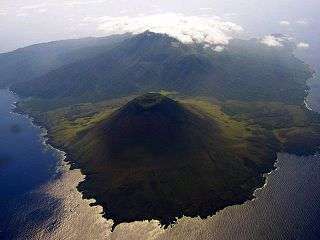Babuyan Islands
 Babuyan Islands of Luzon Strait | |
.svg.png) Babuyan Islands Location within the Philippines | |
| Geography | |
|---|---|
| Location | Luzon Strait |
| Coordinates | 19°15′N 121°40′E / 19.250°N 121.667°ECoordinates: 19°15′N 121°40′E / 19.250°N 121.667°E |
| Adjacent bodies of water | |
| Major islands |
|
| Administration | |
| Region | Cagayan Valley |
| Province | Cagayan |
| Municipality | |
The Babuyan Islands (/bɑːbəˈjɑːn/ bah-bə-YAHN), also known as the Babuyan Group of Islands, is an archipelago in the Philippines, located in the Luzon Strait north of the main island of Luzon. The archipelago consists of four major islands and their surrounding smaller islands. These main islands are, counterclockwise starting from northeast, Babuyan, Calayan, Dalupiri, Fuga, and Camiguin. The Babuyan Islands are separated from Luzon by the Babuyan Channel, and from the province of Batanes to the north by the Balintang Channel.
People
The origins of the Babuyan people date back some 60,000+ years ago when Negrito tribes inhabited the islands, later Austonesians migrated to the islands. In the late 1580s large groups Filipinos fled the mainland when Spain began to invade the Philippines. The small islands now have a mixture of different ethnic groups. Since the early 1800s people from Hawaii, Samoa, Tonga and even Japan have settled on the group of islands. While the native people are considered Filipino they are an ethnic mix of the people from Samoa, Hawaii, Japan and Tonga that now call the islands home.
Religion
Some Babuyan people are majority polytheistic and believe in multiple gods, others practice Hinduism. In the 1940s American soldiers introduced the native people to the Christian religion and now 30% of the natives are Christian.
Government
The whole archipelago is administered under the province of Cagayan with Babuyan, Calayan, Camiguin, and Dalupiri comprising the municipality of Calayan[1] while Fuga is under the municipality of Aparri.[2] Babuyan and Dalupiri are themselves individual barangays in Calayan municipality, respectively named Babuyan Claro and Dalupiri, while Fuga Island is also an individual barangay, also named Fuga Island, in Aparri.
Humpback Whales have re-colonized into the area and the Babuyan became the only wintering ground for the species in the Philippines.[3][4]
Geology

The eastern islands of the archipelago are part of the Luzon Volcanic Arc. Three volcanoes from two of the islands have erupted in historical times – Camiguin de Babuyanes on Camiguin Island,[5] Babuyan Claro (also known as Mount Babuyan) on Babuyan Island. Smith Volcano is in Camiguin Island [6] Another small volcanic island located just 22 km (14 mi) NE of Camiguin Island, Didicas Volcano on Didicas Island, became a permanent island only during the activity of 1952.[7]
Islands
The following are the islands of Babuyan and their adjoining islets and rocks:[8]
|
|
References
- ↑ "Calayan". Official Website of the Provincial Government of Cagayan. Retrieved on 2013-04-01.
- ↑ "Aparri". Official Website of the Provincial Government of Cagayan. Retrieved on 2013-04-01.
- ↑ The BALYENA.ORG. humpback whale research in the babuyan islands – research, education and conservation. Retrieved on December 25. 2014
- ↑ The Center for Rural Empowerment and the Environment. Humpback Whales – Philippines – Babuyan Islands humpback whales project.. Retrieved on December 25. 2014
- ↑ "Camiguin de Babuyanes". Global Volcanism Program. Retrieved on 2013-04-01.
- ↑ "Babuyan Claro". Global Volcanism Program. Retrieved on 2013-04-01.
- ↑ "Didicas". Global Volcanism Program. Retrieved on 2013-04-01.
- ↑ U.S. Coast and Geodetic Survey (1919). "United States Coast Pilot, Philippine Islands, Part 1", pp. 41–44. Government Printing Office, Washington.